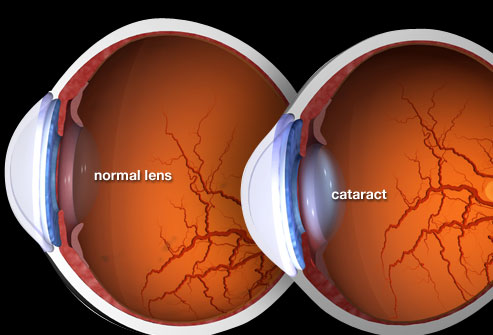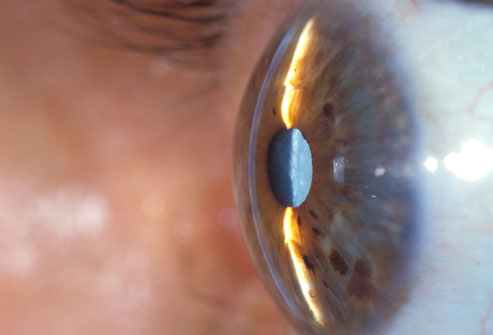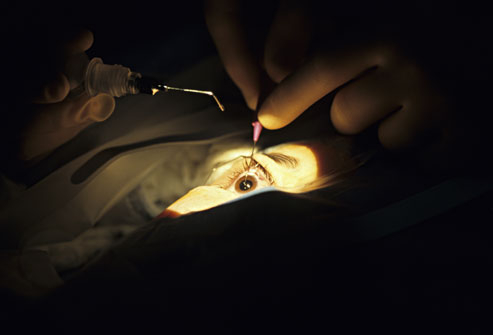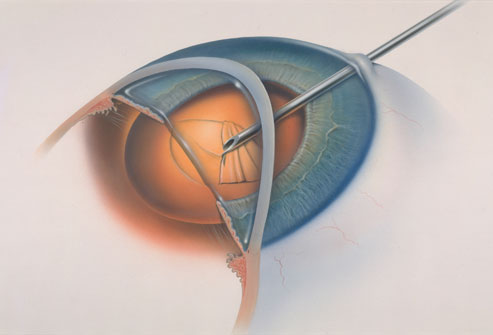CATARACT
What Causes Cataracts?
The eye functions much like a camera. Light rays enter the eye, passing through the cornea, the aqueous humor -- transparent fluid in the front of the eye -- and then the pupil and into the lens. The lens bends the light rays to focus objects onto the retina lining the back of the eye. From there, the image passes through the retinal cells, into the optic nerve, and finally to the back of the brain which process the images.
Cataracts occur when there is a buildup of protein in the lens that makes it cloudy. This prevents light from passing clearly through the lens, causing some loss of vision. Since new lens cells form on the outside of the lens, all the older cells are compacted into the center of the lens resulting in the cataract.
Types of cataracts include:
- Age-related cataracts. As the name suggests, this type of cataract develops as a result of aging.
- Congenital cataracts. Babies are sometimes born with cataracts as a result of an infection, injury, or poor development before they were born, or they may develop during childhood.
- Secondary cataracts. These develop as a result of other medical conditions, like diabetes, or exposure to toxic substances, certain drugs (such as corticosteroids or diuretics), ultraviolet light, or radiation.
- Traumatic cataracts. These form after injury to the eye.
Other factors that can increase a person's risk of developing cataracts include cigarette smoke, air pollution, and heavy alcohol consumption
What Are the Symptoms of Cataracts?
Cataracts usually form slowly and cause few symptoms until they noticeably block light. When symptoms are present, they can include:
- Vision that is cloudy, blurry, foggy, or filmy
- Progressive nearsightedness in older people often called "second sight" because although their distance vision is deteriorating, they may no longer need reading glasses.
- Changes in the way you see color because the discolored lens acts as a filter.
- Problems driving at night such as glare from oncoming headlights.
- Problems with glare during the day.
- Double vision while looking through the eye with a cataract (like a superimposed image).
- Sudden changes in glasses prescription.
How Are Cataracts Diagnosed?
An eye exam will be given to test how well you can see (remember to bring your glasses or wear your contacts to the appointment). Your doctor will also dilate your pupil in order to examine the condition of the lens and other parts of the eye.
How Are Cataracts Treated?
If your vision can be corrected to an acceptable level with a change in prescription, eyeglasses, including bifocals or contacts, may be prescribed, eliminating the need for surgery at that time.
If your vision loss cannot be corrected with new glasses and cataracts interfere with your daily life, you may be a candidate for cataract surgery, which involves removing the clouded lens and replacing it with a clear, artificial one.
Cataract surgery is usually conducted on an outpatient basis and is very successful in restoring vision. It is the most frequently performed surgery in the U.S., with more than 1.5 million cataract surgeries done each year. Far more tan 90 percent of the people who have cataract surgery have improvement in vision.
Talk to your doctor to see which treatment is right for you.
Can Cataracts Be Prevented?
Because the exact cause of cataracts is uncertain, there is no proven method of preventing them. Because cataracts and other conditions such as glaucoma are common in older adults, it's important to have your eyes examined on a regular basis.
This is particularly important if you have risk factors or a family history of eye problems. Adults should see an eye doctor at least every two years and annually after age 50.
People with a history of eye problems or other medical conditions that increase the risk of eye disease -- such as diabetes -- may need eye exams more frequently.
Be sure to ask your doctor if you have any risk factors or indications that cataracts or other conditions may affect your vision.

How Cataracts Affect Your Vision
In a normal eye, light enters and passes through the lens. The lens focuses that light into a sharp image on the retina, which relays messages through the optic nerve to the brain. If the lens is cloudy from a cataract, the image you see will be blurry. Other eye conditions, such as myopia, cause blurry vision, too, but cataracts produce some distinctive signs and symptoms.

Cataract Symptom: Blurry Vision
Blurry vision at any distance is the most common symptom of cataracts. Your view may look foggy, filmy, or cloudy. Over time, as the cataracts get worse, less light reaches the retina. People with cataracts may have an especially hard time seeing and driving at night.

Cataract Symptom: Glare
Another early symptom of cataracts is glare, or sensitivity to light. You may have trouble seeing in bright sunlight. Indoor lights that once didn’t bother you now may seem too bright or have halos. Driving at night may become a problem because of the glare caused by street lights and oncoming headlights.

Cataract Symptom: Double Vision
Sometimes, cataracts can cause double vision (also known as diplopia) when you look with one eye. This is different from the double vision that comes from the eyes not lining up properly. With cataracts, images appear double even with one eye open.

Cataract Symptom: Color Changes
Cataracts can affect your color vision, making some hues look faded. Your vision may gradually take on a brownish or yellowish tinge. At first, you may not notice this discoloration. But over time, it may make it harder to distinguish blues and purples.

Cataract Symptom: Second Sight
Sometimes, a cataract may temporarily improve a person’s ability to see close-up, because the cataract acts as a stronger lens. This phenomenon is called second sight, because people who may have once needed reading glasses find that they don’t need them anymore. As the cataract worsens however, this goes away and vision worsens again.

Cataract Symptom: New Prescription
Frequent changes to your eyeglass or contact lens prescription can be a sign of cataracts. This is because cataracts are usually progressive, meaning they get worse over time.

Who Gets Cataracts?
The majority of cataracts are related to aging. More than half of Americans over 65 have cataracts. Babies are sometimes born with cataracts,also called congenital cataracts, or children may develop them as a result of injury or illness.

What Causes Cataracts?
The exact cause of cataracts is unknown. While the risk grows as you get older, these factors may also contribute:
Diabetes
Smoking
Excess alcohol use
Eye Injury
Prolonged use of corticosteroids
Prolonged exposure to sunlight or radiation

How Are Cataracts Diagnosed?
Most cataracts can be diagnosed with an eye exam. Your eye doctor will test your vision and examine your eyes with a slit lamp microscope to look for problems with the lens and other parts of the eye. The pupils are dilated to better examine the back of the eye, where the retina and optic nerve lie.

Surgery for Cataracts
If you have vision loss caused by cataracts that can’t be corrected with glasses or contact lenses, you may need surgery to remove the cataracts. In cataract surgery, the cloudy lens is removed and replaced with an artificial lens. The surgery, which is done on an outpatient basis, is safe and extremely effective at improving vision. If cataracts are present in both eyes, surgery will be done on one eye at a time.

Types of Cataract Surgery
There are two types of cataract surgery. In the more common type, called phacoemulsification (phaco), the doctor makes a tiny incision in the eye and breaks up the lens using ultrasound waves. The lens is removed, and an intraocular lens (IOL) is put in its place. In most modern cataract surgeries the IOL eliminates the need for thick glasses or a contact lens after surgery.

Cataract Surgery Innovations
Recent developments in cataract surgery can correct both near and distance vision. They minimize or eliminate the need for reading glasses after surgery. Conventional "monofocal" lenses only correct for distance vision, meaning reading glasses are still needed after surgery. "Toric" implants are available to correct astigmatism. A lens for better color vision is in development (shown here next to a dime).

What to Expect After Surgery
For a few days, your eye may be itchy and sensitive to light. You may be prescribed drops to aid healing and asked to wear an eye shield or glasses for protection. It'll take about eight weeks for your eye to heal completely, though your vision should begin to improve soon after surgery. You may still need glasses, at least occasionally, for distance or reading -- as well as a new prescription after healing is complete.

Cataract Surgery Risks
Complications from cataract surgery are rare. The most common risks are bleeding, infection, and changes in eye pressure, which are all treatable when caught early. Surgery slightly raises the risk of retinal detachment, which requires emergency treatment. Sometimes, lens tissue left after surgery and used to support the IOL can become cloudy, even years after surgery. This "after-cataract" is easily and permanently corrected with a laser.

Should You Have Cataract Surgery?
Whether or not to have cataract surgery is up to you and your doctor. Rarely cataracts need to be removed right away, but this isn’t usually the case. Cataracts affect vision slowly over time, so many people wait to have surgery until glasses or contacts no longer improve their vision enough. If you don’t feel that your cataracts are causing problems in your day-to-day life, you may choose to wait.

Tips to Prevent Cataracts
Things you can do that may lower your risk of developing cataracts:
Don't smoke.
Always wear a hat or sunglasses in the sun.
Keep diabetes well controlled.
Limit alcohol consumption.
You can always contact our customer service team over the phone on +6019 2877 766 or email your enquries to info@vfocusvisiononline.com.my, and they’ll be happy to assist you. Kindly visit our website vfocusvisiononline.com.my to check our available retail store.